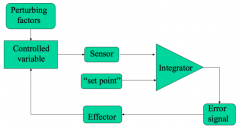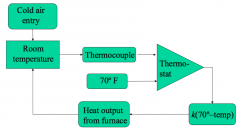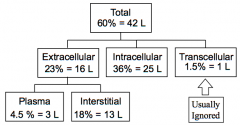![]()
![]()
![]()
Use LEFT and RIGHT arrow keys to navigate between flashcards;
Use UP and DOWN arrow keys to flip the card;
H to show hint;
A reads text to speech;
47 Cards in this Set
- Front
- Back
|
Sensor |
Measures controlled variable |
|
|
Integrator |
Compares sensor info with set point |
|
|
Error signal |
Output of integrator that controls effector |
|
|
Effector |
Mechanism that ultimately adjusts controlled variable |
|

|

|
|
|
High gain |
Maintains small error - most common |
|
|
Low gain |
Maintains significant error |
|
|
Time lag - short and long |
short - quick response long - long response |
|
|
In a perfect controlled system |
Infinite gain and zero time lag Reality - NOT the case, finite gain and response time |
|
|
Open Loop Feedback |
System normally under negative feedback is disrupted - no + or - feedback Ex - ParkinsonAlso happens normally in rapid systems - to overcome time lag inherent to control system (rapid piano playing, rapid typing) |
|
|
Phospholipid (PL) Structure |

Glycerol (3-C) 2 fatty acids (long hydrocarbon) Phosphate group |
|
|
Saturated fatty acid |
c-c single bonds, higher freezing temp |
|
|
Unsaturated fatty acid |
C=C double bond (at least one) kinks dec freezing temperature |
|
|
Amphipathic |
Part of the molecule polar (hydrophilic), part of the molecule non polar (hydrophobic)
|
|
|
Bilayer membrane |
- Very thin, remarkably stable - Membrane lipids are fluid - lateral diffusion but DO NOT flip from one side to the other - Lipids provide a barrier for for trans-membrane flow of POLAR substance - NO barrier to flow of NON-POLAR substance |
|
|
Total Body Fluid - ECF / ICF |

3 compartments ECF 2 compartments Plasma - circulating in the blood ISF - around body cells |
|
|
Compartments of Body Fluids ECF vs ICF NaKCaClHCO2 |
Na+ 140|10 K+ 4|150 Ca++ 5|3 Cl- 105|2 HCO2- 25|-- |
|
|
IMPORTANT Distinction with Ca++ |
5 ECF vs 3 ICF - total concentrations, not diffusible amount ECF: 50% bound to proteins actual concentration 2.5mM ICF: >99.9% bound - 0.0001mM |
|
|
FORMULA Measurement of Volumes |
Vol = Amount added - amount excreted / concentration in sample Amount excreted = [Urine]xUrine Volume |
|
|
Indicators for measuring TBW |
D2O, antipyrine |
|
|
Indicators for measuring ECF |
Inulin, mannitol
|
|
|
Indicators for measuring TBV |
Radioactive RBCs
|
|
|
Indicators for measuring Plasma |
Radioactive albumin, Evan's Blue |
|
|
FORMULA ICF = |
ICF = TBW - ECF |
|
|
FORMULA ISF = |
ISF = ECF - Plasma |
|
|
FORMULA VBlood = |
VBlood = Vplasma + VRBC Vblood = Vplasma / 1 - Hct |
|
|
FORMULA Einstein Relationship |

x = distance (cm) D = diffusion constant (cm2/s) t = time Large molecule = small D Small molecule D = 10^-5 |
|
|
Bulk Flow |
Used for rapid transport over long distances - relies on pressure difference - Hydrostatic pressure: heart - Pneumatic pressure: in lungs |
|
|
FORMULA Net Flow |
Flownet = AP(C1-C2) C1>C2 solute accumulates in the cell C12 solute leaves the cell C1=C2 zero net flow Net flow = 0 can still have unidirectional flow - driving force = concentration difference |
|
|
Simple Diffusion |
NEVER have uphill flow, net flow ALWAYS down a concentration gradient |
|
|
FORMULA Permeability |

Small molecule - Higher P, also higher D Hydrophobic = HIGHER Beta (partition coefficient) |
|
|
Protein mediated transport - Facilitated diffusion |
- high selectivity only transports a certain solute - used to transport polar substances - mediated by protein carriers - bind a solute, undergo conformational change, release on the other side of the membrane - Saturable kinetics, can exhibit competitive inhibition - NO UPHILL |
|
|
Primary Active Transport |
- All of the characteristics of facilitatedBUT can move from low -> high concentration "UPHILL" - Mediated by altering solute binding affinity of carrier - Requires energy - ATP |
|
|
Na+,K+-ATPase - Sodium Pump |
Example of PAT 3 Na+ out of cell, 2 K+ into cell Uses 1 ATP molecule Need to maintain cell volume |
|
|
Ouabain / digitalis / digoxin |
Cardiac-glycoside drug, inhibits the sodium pump |
|
|
Other Primary Active Transport Examples |
Calcium pump, proton pump, H+/K+ exchange pumps |
|
|
Secondary Active Transport |
- All of the characteristics of facilitated BUT can move from low -> high concentration "UPHILL" - Dependent on Na+ gradient - Cotransporters |
|
|
H2O Transport |
- Mediated via osmosis - NO primary active transport - Moves via osmosis - high -> low concentration |
|
|
Solutes in Solution |
Solutes take up space, dec water concentration 1 M glucose = sucrose = AA 1 M glucose = 0.5 NaCl = 1/3 CaCl2 |
|
|
Hyperosmotic |
Hyperosmotic bath > cell |
|
|
Isosmotic |
Isosmotic bath = cell |
|
|
Hypo-osmotic |
Hypo-osmotic bath < cell |
|
|
Immediate Response Look at |
OSMOLARITY - chemical property Hyperosmotic - shrinks Isosmotic - no change Hypo-osmotic - cell swells |
|
|
Tonicity |
What happens when cell placed in solution |
|
|
Hypertonic |
Cell shrinks |
|
|
Isotonic |
No change
|
|
|
Hypotonic |
Cell swells |

